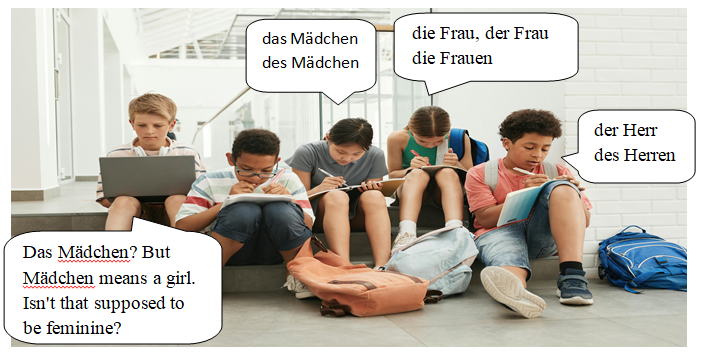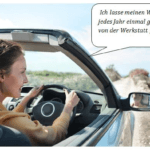In this lesson, you will learn all about the declension of German nouns. What types of declensions there are, how they are divided, how they sound, and how they are used.
Thank you for reading this post, don't forget to subscribe!CONTENTS
Declensions of masculine nouns
Declensions of feminine nouns
Declensions of masculine and neuter nouns
Double nouns with the same and different meanings
The declension of German nouns has two numbers and four cases. Numbers are SINGULAR and PLURAL. The cases are NOMINATIVE, GENITIVE, DATIVE, and ACCUSATIVE.
The declension of nouns is divided into the following declensions :
1. Declensions of masculine nouns/ Die mänliche Declination (N-declension)
2. Declensions of feminine nouns/ Die weibliche Declination
3. Declensions of masculine and neuter nouns/ Die mänliche und sächliche Declination
Click on:
Grammar Contents
Declensions of masculine nouns/ Die männliche Deklination
The declensions of masculine nouns have the suffix -en (after a consonant) or –n (after a vowel) in all cases except for the nominative singular. This declension has no UMLAUT in the plural.
SINGULAR
| N. | der Mensch | der Knabe | der Pole |
| A. | den Mensch-en | den Knabe -en | den Pole-n |
| D. | dem Mensch-en | dem Knabe -en | dem Pole-n |
| G. | des Mensch-en | des Knabe -en | des Pole-n |
PLURAL
| N. | die Mensch-en | die Knabe -en | die Pole-n |
| A. | die Mensch-en | die Knabe -en | die Pole-n |
| D. | den Mensch-en | den Knabe -en | den Pole-n |
| G. | der Mensch-en | der Knabe -en | der Pole-n |
The masculine declension is followed by many masculine nouns, which denote living beings, as well as many names of people:
der Ochs (the ox), der Bär (the bear), der Löwe (the lion), der Mensch (the man), der Junge (the boy), der Knabe (the boy), der Serbe (the Serb), der Franzose (the Frenchman), …
But also other masculine nouns (mainly nouns of foreign origin) such as der Praktikant (the intern), and der Komet (the comet).
NOTE: The noun der Herr has the ending -n in the singular, and the ending -en in the plural.
| singular | plural |
| die Herr | die Herren |
| den Herrn | die Herren |
| dem Herrn | den Herren |
| des Herrn | der Herren |
Declensions of feminine nouns / Die weibliche Deklination
In the singular, feminine nouns remain in all cases without an ending. According to the endings of the nominative plural, we distinguish:
1st declension (without endings)
2nd declension (with the ending -e)
3rd deklinaciju ( with the ending -en)
1st declension (without ending)
The first declension remains in the nominative, genitive, and accusative plural without an ending, in the dative plural it has the ending -n.
SINGULAR
| N. | die Mutter | die Tochter |
| A. | die Mutter | die Tochter |
| D. | der Mutter | der Tochter |
| G. | der Mutter | der Tochter |
| N. | die Mütter | die Töchter |
| A. | die Mütter | die Töchter |
| D. | der Mütter-n | der Töchter-n |
| G. | der Mütter | der Töchter |
Only the nouns die Mutter and die Tochter follow the first declension. Both have Umlaut in the plural.
2nd declension / Die zweite Deklination
The second declension has the ending -e in the nominative, genitive, and accusative plurals, and -en in the dative.
SINGULAR
| N. | die Hand | die Kenntnis | die Mühsal |
| A. | die Hand | die Kenntnis | die Mühsal |
| D. | der Hand | der Kenntnis | der Mühsal |
| G. | der Hand | der Kenntnis | der Mühsal |
PLURAL
| N. | die Händ -e | die Kenntnis-e | die Mühsal-e |
| A. | die Händ -e | die Kenntnis-e | die Mühsal-e |
| D. | den Händ -en | den Kenntniss-en | der Mühsal-en |
| G. | der Händ -e | der Kenntnis-e | der Mühsal-e |
After the second declension, there are around 40 one-syllable feminine nouns: die Kuh (the cow), die Hand ( the hand), and feminine nouns in -nis and -sal, e.g. die Kenntnis (the knowledge), die Erlebnis(the experience), die Finsternis (the darkness), die Drangsal (the tribulation), die Trübsal (the affliction), die Schicksal (the fate).
All one-syllable nouns have UMLAUT in the plural, eg: die Kühe (the cows), die Hände (the hands).
Nouns in -nis and -sal do not have Umlaut. Nouns in -nis get double –s in the plural.
3rd declension / Die dritte Deklination
The third declension has in all plural cases the ending -en (after a consonant) and after -e, -el, and -er it has the ending -n.
SINGULAR
| N. | die Frau | die Wiese | die Studentin |
| A. | die Frau | die Wiese | die Studentin |
| D. | der Frau | der Wiese | der Studentin |
| G. | der Frau | der Wiese | der Studentin |
PLURAL
| N. | die Frau -en | die Wiese -n | die Studentin –nen |
| A. | die Frau -en | die Wiese -n | die Studentin –nen |
| D. | den Frau -en | den Wiese -n | der Studentin –nen |
| G. | der Frau -en | der Wiese -n | der Studentin –nen |
The third declension follows most feminine nouns, for example: die Tante (the aunt), die Tafel (the blackboard), die Feder (the spring), and die Übung (the exercise), this also includes one-syllable nouns: die Frau (the woman), die Uhr (the clock), die Tür (tho door), die Zahl (the number)
This declension has no UMLAUT in the plural.
Feminine nouns in -in get another n in the plural –nen.
For example:
die Lehrerin – die Lehrerinnen
die Ärztin – die Ärztinnen
die Köchin – die Köchinnen
Declensions of masculine and neuter nouns / Die männlich – sächliche Deklination
In the genitive singular, nouns of this declension have the ending -s or -es,
For example:
des Bruder-s
des Haus-es
In the dative singular, they generally do not have the ending or have the ending -e.
For example:
dem Bruder
dem Haus(-e)
The ending -es is needed when the genitive with the ending -s is difficult to pronounce. This is especially true for nouns with -s, -ß, -chs, (x), -tsch, -zi, -zt, and -z.
For example:
das Haus (house) – des Hauses
das Strauß (Bouquet) – des Strauß-es
der Fuchs (fox) – des Fuchs-es
das Index (index) – des Index-es
der Tratsch (gossip) – des Tratsch-es
der Reiz (charm) – des Reiz-es
der Arzt (doctor) – des Arzt-es
Nouns with the ending -es in the genitive often have the ending -e in the dative.
For example:
im Sinne,
dem Haus(e)
According to the ending of plural nouns, we distinguish:
1. the first declension (without ending)
2. the second declension (with the ending -e)
3. the third declension (with the ending -en)
4. the fourth declension (with the ending -er)
The 1st declension / Die erste Deklination
The first declension doesn’t have an ending in nominative, genitive, and accusative plurals. In the dative plural, it ends (like all declensions) in -n. After the first declension, masculine and neuter nouns end in -er, -el, -en.
For example: der Bruder, der Onkel, der Wagen, das Fenster, das Rätsel, das Zeichen,…
SINGULAR
| N. | der Vater | der Apfel | der Wagen |
| A. | den Vater | den Apfel | den Wagen |
| D. | dem Vater | dem Apfel | dem Wagen |
| G. | des Vater-s | des Apfel-s | des Wagen-s |
PLURAL
| N. | die Väter | die Äpfel | die Wagen |
| A. | die Väter | die Äpfel | der Wagen |
| D. | den Väter-n | den Äpfel-n | den Wagen |
| G. | der Väter | die Äpfel | des Wagen-s |
Also, pronouns (diminutives) that end in -chen and -lein, for example, das Fensterchen, and das Tischlein, neuter nouns with the prefix Ge- and the ending -e, for example das Gebirge, das Gemüse, and masculine nouns in -en, which in the nominative singular end in -e. eg: der Gedanke, des Gedanke-ns etc., der Name, des Name-ns etc.
SINGULAR
| N. | das Mädchen | das Gebirge | der Gedanke |
| A. | das Mädchen | das Gebirge | den Gedanken |
| D. | dem Mädchen | dem Gebirge | dem Gedanken |
| G. | des Mädchen-s | des Gebirge-s | des Gedanken-s |
PLURAL
| N. | die Mädchen | die Gebirge | die Gedanken |
| A. | die Mädchen | die Gebirge | die Gedanken |
| D. | den Mädchen | den Gebirge-n | den Gedanken |
| G. | der Mädchen | der Gebirge | der Gedanken |
Many masculine nouns have UMLAUT in the plural, eg: der Vater – die Väter, der Bruder – die Brüder.
NOTE: nouns in -en do not have an ending.
The 2nd Declension / Die zweite Deklination
The second declension has the suffix -e in the nominative, genitive, and accusative plurals, and -en in the dative plural.
SINGULAR
| N. | der Fuß | das Jahr | das Zeugnis |
| A. | den Fuß | das Jahr | das Zeugnis |
| D. | dem Fuß | dem Jahr | dem Zeugnis |
| G. | des Fuß-es | des Jahr-s | des Zeugniss-es |
PLURAL
| N. | die Füß-e | die Jahr-e | die Zeugniss-e |
| A. | die Füß-e | die Jahr-e | die Zeugniss-e |
| D. | den Füß-en | den Jahr-en | den Zeugniss-en |
| G. | der Füß-e | der Jahr-e | der Zeugniss-e |
The second declension is followed by many (mostly one-syllable) masculine and neuter nouns, including masculine nouns in -ling and neuter nouns in -nis and -sal, e.g. der Ball (ball), der Schwanz (tail), der Schilling (shilling), das Tier (animal), das Schaf (sheep), das Zeugnis( testimony), das Schicksal (fate).
Most masculine nouns have the Umlaut plural, e.g. der Ball – die Bälle, der Kopf – die Köpfe. Die Nouns in –nis get in the genitive singular and plural two letters -s-.
The 3rd declension/ Die dritte Deklination
The third declension in all plural cases has the ending -en (after the consonant), after the vowel in nouns in –e, -er, and -el it has the ending -n.
SINGULAR
| N. | der Schmerz | das Auge |
| A. | den Schmerz | das Auge |
| D. | dem Schmerz(-e) | dem Auge |
| G. | des Schmerz -es | des Auge-s |
PLURAL
| N. | die Schmerz-en | die Auge-en |
| A. | die Schmerz-en | die Auge-en |
| D. | den Schmerz-en | den Auge-en |
| G. | der Schmerz-en | der Auge-en |
After the third declension there are 13 masculine nouns: der Dorn (thorn), der Gevatter (godfather), der Mast (mast), der Pantoffel (house slippers), der Pfau (peacock), der Schmerz (pain), der See (lake ), der Sporn (spur, lathe) (PL. Die Sporen), der Staat (state), der Stachel (sting, thorn), der Strahl (beam), der Vetter (cousin), der Zins (interest), and 6 neuter nouns: das Auge (eye), das Bett (bed), das Ende (end), das Hemd (shirt), das Ohr (ear), das Leid (suffering) (remember the initial letters ABEHOL). This declension does NOT have an Umlaut in the plural.
NOTE: Das Herz has the correct singular declension (des Herzens, dem Herzen, das Herz), and the plural is correct (die, der, den, die Herzen)
The 4th declination / Die vierte Deklination
The fourth declension has the suffix -er in the nominative, genitive, and accusative plurals, and the ending -ern in the dative plural.
SINGULAR
| N. | das Haus | der Mann |
| A. | das Haus | den Mann |
| D. | dem Haus (-e) | dem Mann |
| G. | des Haus-es | des Mann-s |
PLURAL
| N. | die Häus-er | die Männ-er |
| A. | die Häus-er | die Männ-er |
| D. | den Häus-ern | den Männ-ern |
| G. | der Häus-er | der Männ-er |
Most one-syllable neuter nouns follow the fourth declension: das Haus (house), das Kind (child), das Dorf (village), masculine nouns: der Geist (spirit), der Gott (god), der Leib (corpse), der Mann (man), der Mund (mouth), der Rand (edge), der Strauch (shrub, bush), der Vormund (quardian), der Wald (forest, woods), der Wurm (worm) and all masculine and neuter nouns in -tum, e.g. der Irrtum, der Reichtum, das Faktum.
All nouns that have the vowels a, o, and au in their base, as well as nouns in –tum, e.g. der Mann – die Männer, das Dorf – die Dörfer, das Buch – die Bücher, das Haus – die Häuser, der Irrtum – die Irrtümer.
NOTE: in the declension of masculine and neuter nouns, numbers are sometimes followed by the old plural noun without a suffix (mainly when the noun indicates a measure), eg: 3 Glas Wein, 5 Paar Strümpfe, 20 Euro, 80 Mann, 5 Stück Brot, 10 Kilogram Mehl.
Click on:
Grammar Contents
Double nouns with the same and different meanings
NOTE: some plural nouns can have double forms with the same or different meanings. The most common are:
WITH THE SAME MEANING
| SINGULAR | PLURAL | PLURAL |
| der Bösewicht(Villain) | die Bösewichter | die Bösewichte |
| der Mast | die Masten | die Maste |
| der Mund | die Münder | die Munde (Münde) |
| der Herzog | die Herzöge | die Herzoge |
WITH DIFFERENT MEANING:
| SINGULAR | PLURAL | PLURAL |
| das Band | die Bänder (ribbons) | die Bande (shackles) |
| die Bank | die Bänke (benches) | die Banken (banks) |
| das Gesicht | die Gesichter (faces) | die Gesichte (apparitions) |
| der Mann | die Männer (men) | die Mannen (vassals, fighters) |
| die Mutter | die Mütter (mothers) | die Muttern (Screw Nuts) |
| der Strauß | die Sträuße (bouquets) | die Strauße (ostriches) |
| das Wort | die Wörter (individual words) | die Worte (words as a part) |
| der Zins | die Zinse (rents) | die Zinsen (interests) |
NOTE: When the genitive plural stands without an article or adjective, it does not differ from the nominative and accusative, and then von + Dative is used.
For example:
Zeichnungen von Kindern.
See more:


